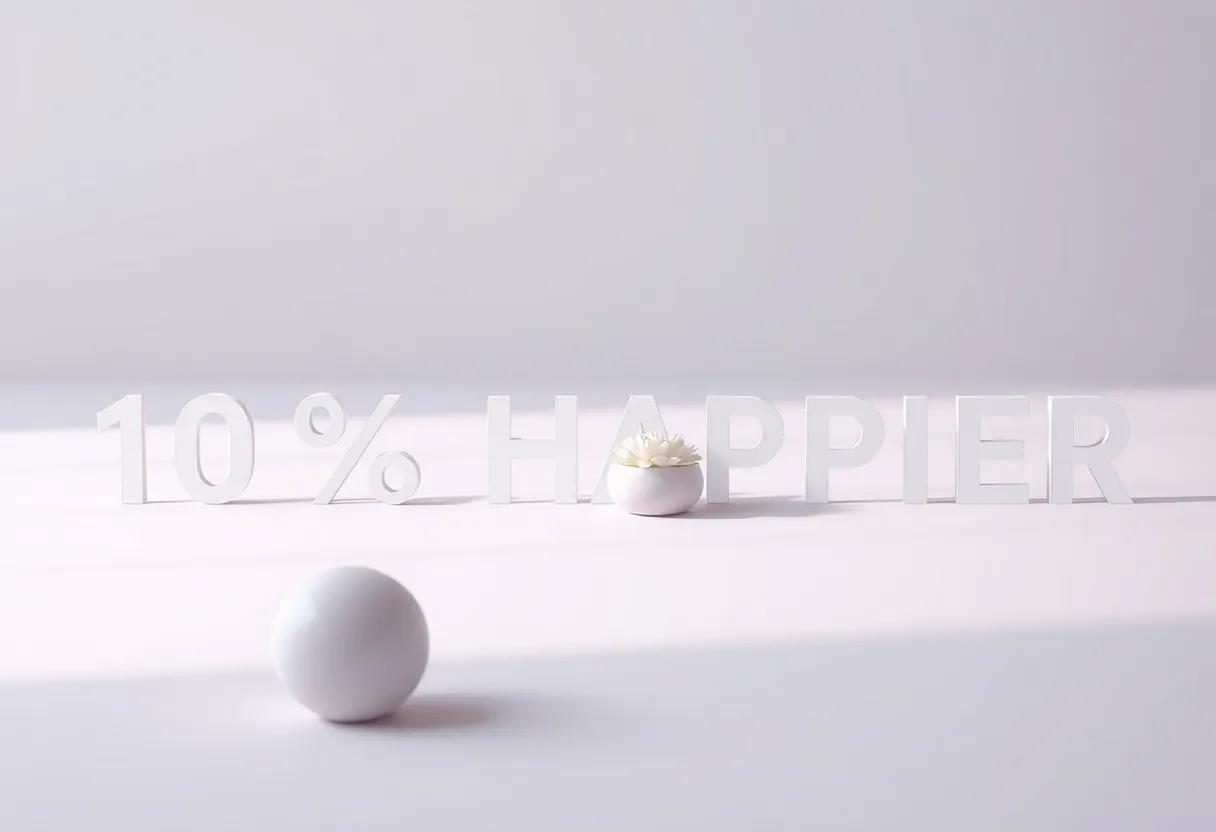in a world that often feels relentlessly fast-paced and overwhelmingly noisy, the search for calm can seem both elusive and essential. Dan Harris’s 10% Happier chronicles one such quest-not as a miraculous transformation, but as a pragmatic exploration into mindfulness and meditation. Finding Calm: A Thoughtful Look at Dan Harris’s 10% Happier Journey invites readers to revisit this well-known narrative through a reflective lens, examining the intersections of skepticism, self-finding, and the subtle art of tuning inward. This review navigates the contours of Harris’s experience,offering insights into how his story resonates beyond the personal to touch broader questions about happiness and mental clarity in today’s world.
Exploring the Core Themes and Mindfulness Techniques Presented in Dan Harris’s 10% Happier Journey
At the heart of Dan Harris’s journey lies an exploration of the transformative power of mindfulness-a practice often misunderstood as mere relaxation. Throughout his experience, Harris sheds light on how mindfulness acts as a powerful tool for rewiring the brain, fostering awareness, and cultivating emotional resilience. What makes his approach resonate so well is its accessibility; mindfulness isn’t portrayed as an esoteric or mystical practice, but rather a down-to-earth method to counter stress, anxiety, and the relentless noise of modern life. This relatable framing invites readers to rethink how they approach their own mental well-being, emphasizing that incremental progress-just 10%-can lead to meaningful change over time.
Integral to his narrative are practical techniques that democratize meditation and mindfulness for skeptics and beginners alike. Some of the standout methods he discusses include:
- Focused breathing: Harnessing the natural rhythm of breath to anchor the mind away from distractions.
- Body scanning: Cultivating a connection to physical sensations that anchor awareness in the present moment.
- Labeling thoughts: Learning to identify and categorize thoughts without judgment to reduce their emotional grip.
| Technique | Purpose | Benefit |
|---|---|---|
| Focused Breathing | Center attention | Calms nervous system |
| Body Scanning | Enhance bodily awareness | Reduces stress buildup |
| Labeling Thoughts | Observe mind patterns | Limits emotional reactivity |
By demystifying these core themes and tools, Harris opens up a pathway not just toward calmness, but toward sustained mental clarity and self-compassion. His work encourages embracing imperfections and patience, making mindfulness an inviting practice for anyone striving for a healthier relationship with their inner world.
How Practical Meditation advice Balances Skepticism and Optimism in the Narrative
Dan Harris’s journey through meditation is refreshingly grounded, inviting readers to explore mindfulness without the haze of dogma or blind faith.His narrative embraces healthy skepticism, acknowledging the allure and pitfalls of meditation hype while still uncovering genuine benefits. This balanced stance encourages readers to question lofty promises often attached to spiritual practices and instead try meditation as a practical tool for enhancing daily life. Inviting both curiosity and caution, Harris models an approach where experience outweighs ideology, allowing personal insight to shape one’s path.
The practicality of his advice also lies in simple, actionable recommendations that resonate with busy, modern lifestyles. Rather than prescribing rigid rituals, he offers flexible techniques like mindful breathing and brief daily sessions, making meditation accessible and manageable. Below is a brief glimpse of how his approach balances *expectations* versus *realities*:
| Expectation | Reality |
|---|---|
| Meditation instantly eradicates stress | it builds resilience through consistent effort |
| It requires long, uninterrupted sessions | Even 5 minutes can be impactful |
| Perfect empty-mind state is mandatory | Awareness of wandering thoughts is part of the process |
- Embrace imperfection: Meditation is a practice, not a performance.
- Approach with curiosity: Questions are welcome, but don’t let skepticism prevent trying.
- Be patient: Benefits accumulate over time, not overnight.
The Role of Personal Vulnerability and Honesty in Conveying Mental Health Challenges
in his candid exploration of mindfulness and mental clarity, Dan Harris demonstrates how openness about personal struggles can bridge the gap between stigma and understanding. His willingness to share moments of anxiety, doubt, and imperfection creates a raw authenticity that resonates with readers and listeners alike. This vulnerability invites others to acknowledge their own mental health challenges without shame, fostering a collective environment where honesty becomes a catalyst for healing. It’s not just about declaring struggles; it’s about embracing them as part of a human experience that everyone shares, yet often hides.
The power of this honest narrative lies in several key areas:
- Relatability: Personal stories break down abstract concepts into tangible realities.
- Destigmatization: Admitting imperfection normalizes conversations about mental health.
- Empowerment: Showing recovery and management inspires proactive steps in others.
- Connection: Shared vulnerability builds communities of support and understanding.
| Vulnerability Aspect | Impact on Audience |
|---|---|
| Confession of anxiety | Normalizes common fears |
| Struggle with ego | Humanizes public figures |
| Imperfect meditation journey | Encourages patience in practice |
| Open discussions about therapy | Reduces stigma around seeking help |
Unpacking the Science Behind Mindfulness as Explained Through Harris’s Experiences
Dan Harris’s journey into mindfulness began not as a spiritual quest but as a practical experiment fueled by the intense pressure of his career in broadcast journalism. Through his candid recounting, readers understand that mindfulness is far more than just sitting quietly; it is a scientifically grounded practice that can rewire the brain. Harris’s experiences reveal how mindfulness activates the prefrontal cortex-the brain’s center for decision-making and emotional regulation-while calming the amygdala, the part responsible for stress and fear responses. This neurological shift helps explain why consistent practice can foster greater emotional resilience, reduce anxiety, and enhance overall cognitive clarity.
Beyond the personal anecdote, Harris also touches on measurable benefits validated by research. For instance, mindfulness training has been shown to improve attention span and increase grey matter density in areas linked to learning and memory. to summarize the core benefits he uncovered during his journey, here’s a snapshot:
| Aspect | Scientific Insight | Harris’s Reflection |
|---|---|---|
| Attention | Enhanced focus and reduced mind-wandering | “I noticed moments where my racing thoughts paused.” |
| Emotional Regulation | Lowered activity in brain regions tied to stress | “I felt less overwhelmed even in chaotic situations.” |
| Neuroplasticity | Increased gray matter in learning/memory areas | “I became more adaptable in processing my experiences.” |
- Mindfulness is practical. It’s a tool accessible to anyone seeking balance.
- Science supports the benefits. This is more than just a trend; it’s a viable mental health strategy.
- personal transformation is possible. Harris’s story demonstrates real-world impact beyond theory.
Analyzing the Transformation from Media Stress to Mindful Awareness in Everyday Life
In a world oversaturated with a constant barrage of notifications, headlines, and social media updates, it’s easy to find ourselves trapped in a perpetual state of media-induced tension. Dan Harris’s journey highlights how this cycle of anxiety doesn’t stem just from *what* we consume but *how* we engage with it. By shifting focus from reactive consumption to intentional reflection, the jagged curve of stress smooths into a calmer rhythm. This transformation encourages us to pause between the stimulus and our response, cultivating a mental space where mindful awareness flourishes rather than frays.
key factors contributing to this shift include:
- Recognizing habitual reactions: Identifying moments when media triggers overwhelm or fear.
- Practicing deliberate mindfulness: using simple breathing techniques to regain presence.
- Curating information intake: Choosing quality over quantity in daily news and social feeds.
| Old Pattern | Mindful Shift |
|---|---|
| Instant scrolling without thinking | Moment-to-moment conscious awareness |
| Absorbing negative headlines unchecked | Selective reading with emotional boundary |
| Reacting impulsively to news | Pausing, breathing, and choosing response |
This transformation doesn’t require radical lifestyle overhauls; instead, it thrives on small, persistent shifts in daily habits. By creating these gentle interruptions in our media consumption, we allow the mind to settle and develop an increased capacity for calm observation. Harris’s experience serves as a vivid reminder that mindful awareness isn’t an escape from reality but a way to meet it with clarity and composure.
Evaluating the Impact of 10% Happier on Popularizing Meditation for beginners
10% Happier has undeniably reshaped how meditation is perceived among beginners, transforming it from an elusive spiritual practice into a relatable tool for daily stress management. Dan Harris’s candid storytelling bridges the gap between skepticism and curiosity, making meditation accessible without the pressure of achieving perfection. The app’s user-pleasant interface and bite-sized mindfulness exercises appeal to those new to meditation, gently guiding them through the nuances of focus, breathing, and self-awareness. This approach has sparked a cultural shift, encouraging people to explore meditation as a practical life skill rather than a mystical pursuit.
A closer look at user engagement reveals notable trends in how 10% Happier supports beginners:
- Short, approachable sessions that fit into busy schedules
- Scientific backing that alleviates doubts and builds trust
- Guidance from relatable teachers who demystify complex concepts
- Community features fostering connection without intimidation
Below is a glimpse of how the app’s demographics reflect its beginner-friendly impact:
| Age Group | Percentage of New Meditators |
|---|---|
| 18-29 | 42% |
| 30-45 | 35% |
| 46-60 | 18% |
| 60+ | 5% |
Key Takeaways for Readers Seeking Manageable Mental Wellness practices Without Overwhelm
Embracing manageable mental wellness practices begins with recognizing that simplicity frequently enough fosters sustainable change. Dan harris’s journey highlights that even brief moments of mindfulness, when practiced consistently, can gradually ease the grip of anxiety and overthinking. Instead of overwhelming yourself with complex routines, focus on small, intentional habits such as daily breath awareness or short guided meditations.These subtle shifts accumulate, offering a steady path towards clarity without feeling burdensome.Remember, it’s about progress, not perfection-letting go of the pressure to “do it right” can be a powerful step in itself.
Incorporating these ideas can be easier when you break down mental wellness into bite-sized, achievable actions. Consider the following approachable practices that align with Harris’s insights:
- Short Daily Mindfulness: 5-10 minutes focusing on breath or body sensations.
- Nonjudgmental Awareness: Observing thoughts without self-criticism.
- Gentle Curiosity: Exploring emotions with openness rather than avoidance.
- Consistency Over Intensity: Regular practice beats sporadic, intense sessions.
| Practice | Time Commitment | Impact |
|---|---|---|
| Mindful Breathing | 5 minutes | Calms nervous system |
| Body Scan | 10 minutes | Increases body awareness |
| Guided Meditation | 7 minutes | Boosts focus & reduces stress |
| Reflective Journaling | 5 minutes | Clarifies thoughts & feelings |
How Harris’s Writing Style Enhances Accessibility While Maintaining Depth and Substance
Dan Harris strikes a rare balance between clarity and complexity, weaving his insights into language that invites rather than excludes.His prose is approachable without feeling diluted, making mindfulness and meditation accessible to skeptics and novices alike. By avoiding jargon and employing relatable anecdotes, Harris creates a conversational rapport that resonates deeply with readers, encouraging them to explore challenging emotional landscapes confidently. This accessibility is not merely a stylistic choice; it’s a deliberate bridge crafted to welcome diverse audiences into the often-intimidating world of self-awareness.
Yet, beneath this clear surface lies a carefully layered narrative packed with philosophical richness and scientific grounding. The book marries personal vulnerability with research-backed evidence, facilitating a thoughtful dialogue between experience and expertise.The following table expresses this harmony:
| Aspect | Accessibility | Depth & Substance |
|---|---|---|
| Language | Everyday vocabulary | Incorporates mindfulness terminology |
| Narrative | Personal stories | Research references |
| Approach | Humor & candor | Critical insights & skepticism |
This elegant fusion ensures the material remains thought-provoking and substantive, appealing to both casual readers hunting for calm and those seeking a nuanced meditation practice. Harris’s writing dismantles the misconception that depth must come at the expense of accessibility, proving that profound truth can be both inviting and intellectually satisfying.
Visualizing the Intersection of Neuroscience and Spirituality in the Book’s Message
Dan Harris masterfully bridges the frequently enough polarized domains of neuroscience and spirituality, revealing how both can illuminate the human quest for calm and clarity. Through his journey, readers observe an intricate dance between measurable brain activity and the intangible experiences of mindfulness. While neuroscience offers concrete evidence about the brain’s plasticity and how meditation reshapes neural pathways, spirituality delves into the personal, subjective transformations that go beyond data. This fusion is beautifully illustrated by Harris’s candid reflections on his struggles with anxiety and his discovery of meditation-not simply as a practice but as an awakening that aligns brain function with emotional well-being.
To appreciate this connection, consider the following elements that Harris explores, which give a vivid portrayal of the mind-body synthesis:
- Neural rewiring: The brain’s ability to form new neural connections that foster emotional regulation.
- Present-moment awareness: A spiritual principle validated by neuroscience as a way of reducing stress and improving focus.
- Inner dialogue: How conscious observation of one’s thoughts leads to a healthier mental environment.
| Aspect | Neuroscience Outlook | Spiritual Perspective |
|---|---|---|
| Mindfulness | Activation of prefrontal cortex, promoting focus and emotional control | Non-judgmental awareness of the present moment |
| Anxiety Reduction | Decreased amygdala activity lowers stress response | Learning acceptance and letting go of fears |
| Self-Identity | Observation of default mode network changes | Realization of interconnectedness and ego dissolution |
Recommendations for Incorporating 10% Happier’s Insights into Daily Routines and Workplaces
Integrating the wisdom of 10% Happier into everyday life doesn’t require a drastic overhaul-small, intentional shifts can cultivate a more grounded mindset amid modern chaos. Start by weaving brief mindfulness pauses into your daily schedule; even 3-5 minutes of focused breathing or mindful observation can anchor your attention and reduce stress. At work, consider setting reminders for micro-breaks that encourage stepping away from screens and reconnecting with your breath.Emphasizing consistency over duration encourages a sustainable practice that aligns with Harris’s message of achievable,incremental enhancement.
Bringing these principles directly into professional environments can foster more balanced, productive teams. Try introducing group meditation sessions or quiet reflection periods before meetings to clear mental clutter and enhance collective focus.Encouraging open conversations about mindfulness benefits reduces stigma and promotes a culture of well-being. Below is a simple framework to help organize daily mindfulness practices into your routine:
| Time of Day | Practice | Duration | Benefit |
|---|---|---|---|
| Morning | Breath awareness | 5 minutes | Set calm tone |
| Midday | Mindful walk | 10 minutes | Re-energize focus |
| Afternoon | Stress check-in | 3 minutes | Reset perspective |
| Evening | Gratitude reflection | 5 minutes | Enhance positivity |
- Encourage self-compassion: Remind yourself and colleagues that mindfulness is a journey, not a destination.
- Customize practices: Adapt techniques to fit personal and team preferences to maintain engagement.
- Celebrate small wins: Acknowledge progress, fostering motivation for continued growth.
The Broader Cultural Influence of Dan Harris’s Book Within the Wellness Movement
Dan Harris’s 10% Happier didn’t just carve a niche for itself as a meditation guide; it reshaped the way mainstream culture perceives mindfulness. By approaching meditation through the lens of a skeptical journalist and a busy modern professional, Harris bridged a critical gap between ancient practices and contemporary lifestyles. His candid, relatable narrative helped demystify meditation, transforming it from a niche spiritual activity into an accessible tool for everyday stress management and mental clarity. this approachable stance invited a diverse audience-from corporate executives to anxious millennials-to reconsider their mental well-being without the weight of spiritual dogma or esoteric language.
The ripple effects within the wellness movement are palpable:
- Emphasis on practical, scientifically backed mindfulness techniques rather than purely spiritual teachings.
- A surge in meditators seeking secular resources that fit busy, modern lives.
- Integration of mindfulness into professional settings, like Silicon Valley and corporate wellness programs.
| Impact Area | Description |
|---|---|
| Media Representation | More realistic portrayals of meditation in mainstream shows and podcasts. |
| Product Progress | Growth in mindfulness apps that blend science and accessibility. |
| Workplace Culture | Normalizing mental health breaks and meditation sessions during work hours. |
Exploring Additional Resources and Apps Suggested to complement the meditation Journey
To deepen the meditation experience inspired by Dan Harris’s 10% Happier journey, integrating thoughtfully chosen resources and apps can be a game-changer. Alongside the core meditation practices, these tools offer guidance, community support, and tailored mindfulness exercises to fit diverse lifestyles. Among the recommended picks, Insight Timer stands out with its vast library of guided meditations and ability to connect users worldwide, fostering a sense of shared progress. Meanwhile,Headspace provides structured courses that complement the straightforward,scientific approach Harris advocates,making it easier for beginners to form sustainable habits.
Embracing a mixture of formats-audio, video, and interactive workshops-helps maintain engagement and caters to various learning styles. Here’s a simple overview of some standout apps and resources that align well with the 10% Happier ethos:
| App / Resource | Key Feature | ideal for |
|---|---|---|
| 10% Happier App | Practical, science-backed meditation lessons | Those seeking no-nonsense guidance |
| Calm | Soothing sleep stories and breathing techniques | Users wanting relaxation beyond meditation |
| Waking Up | Philosophical deep dives with Sam Harris | Meditators interested in mindful skepticism |
| Smiling Mind | Age-specific mindfulness programs | Families and educators |
about Dan Harris The Journalist Who Bridged the Gap Between Meditation and Mainstream Media
Dan Harris, a seasoned journalist and co-anchor of ABC’s Nightline, redefined the public narrative around meditation by openly sharing his personal struggles with anxiety and self-doubt. Rather than presenting mindfulness as an abstract spiritual practice, he positioned it as an accessible, science-backed tool for improving mental wellness-even in the high-stakes, fast-paced world of mainstream media. His candid account of a panic attack on live television became a pivotal moment, inspiring many to question how they dealt with stress and inviting a broader audience to explore meditation without stigma or skepticism.
What sets Harris apart is his ability to blend journalistic rigor with genuine curiosity, resulting in a relatable journey that resonates with both skeptics and meditation enthusiasts. Through 10% Happier, he demystifies mindfulness with humor and practicality, emphasizing:
- Scientific research supporting meditation’s benefits
- Practical techniques tailored for busy professionals
- Personal anecdotes that humanize the practice
- Encouragement to embrace imperfection in the meditation journey
this unique synthesis has helped bridge a gap, making meditation a topic worthy of serious media attention without losing its approachable spirit.
Finding Calm: A Thoughtful Look at Dan harris’s 10% Happier Journey offers more than just a retelling; it invites readers to walk alongside Harris as he navigates the frequently enough turbulent waters of mindfulness and modern life. Whether you’re a skeptic or a seasoned meditator, this reflective examination provides a balanced, unvarnished perspective that encourages thoughtful consideration rather than quick conclusions. It’s a gentle reminder that the pursuit of happiness-however incremental-remains a deeply personal voyage, one worth exploring with both curiosity and patience.











